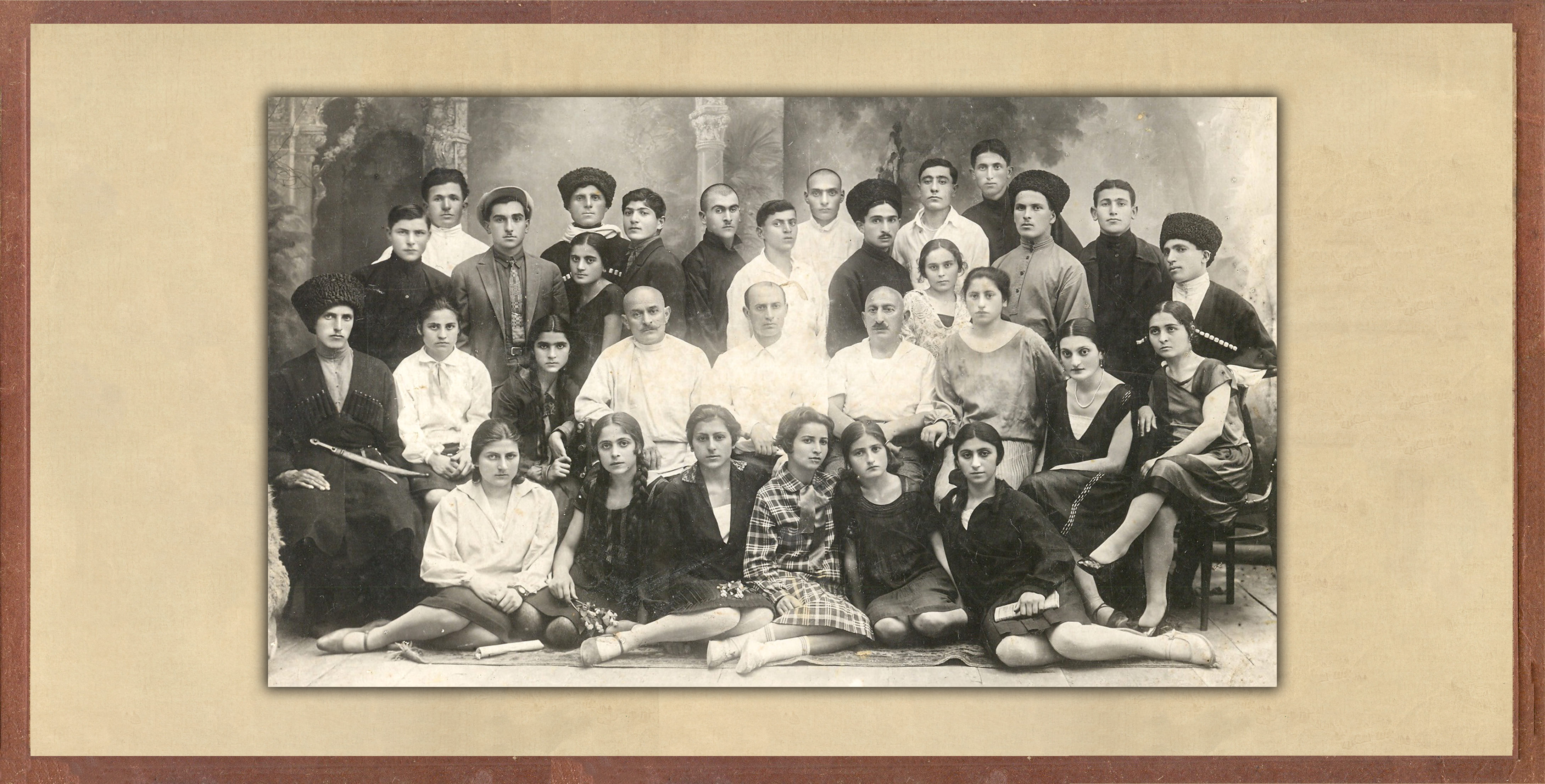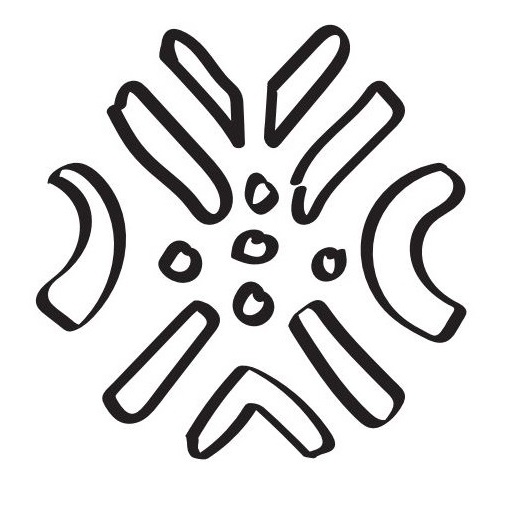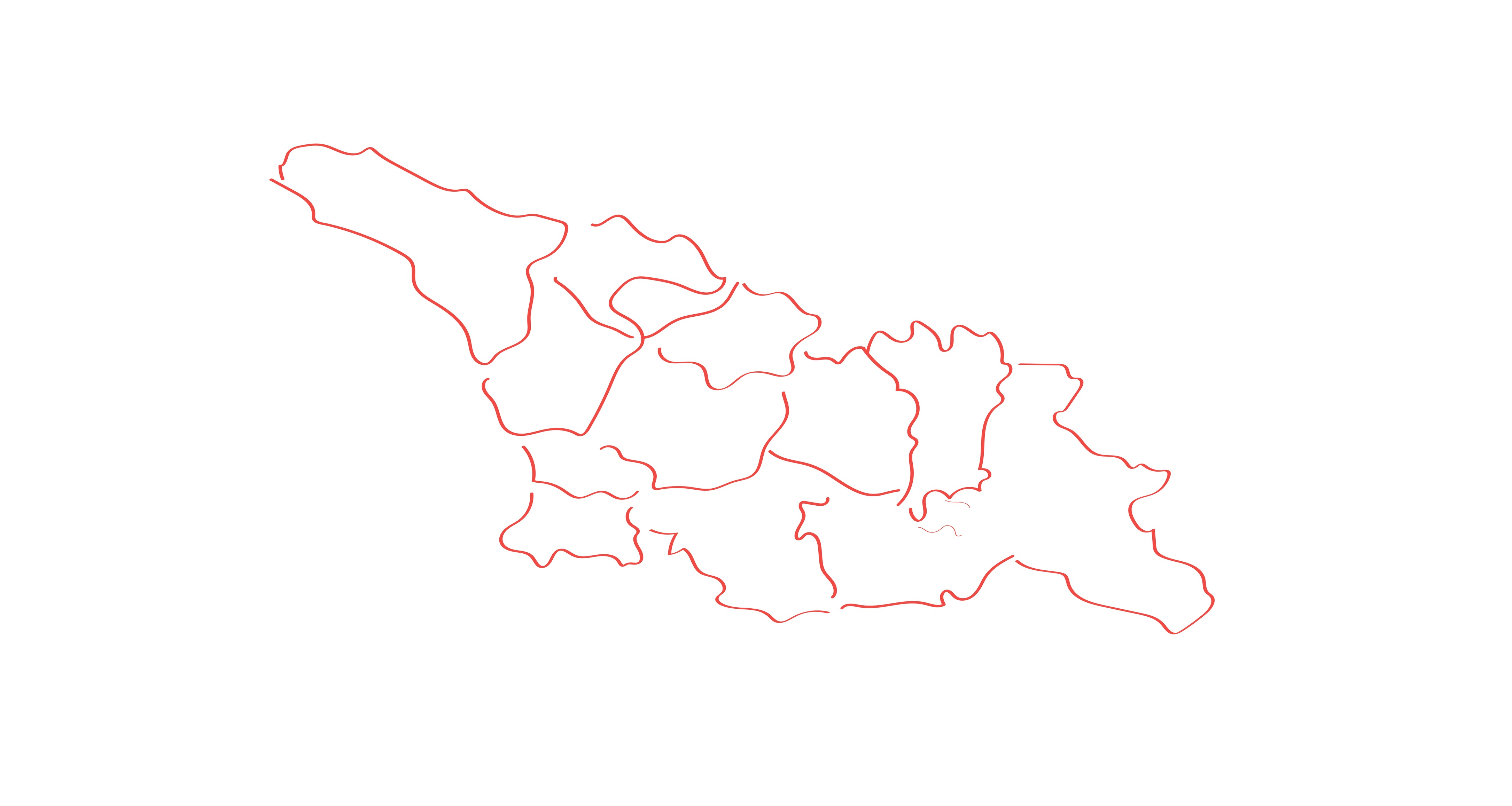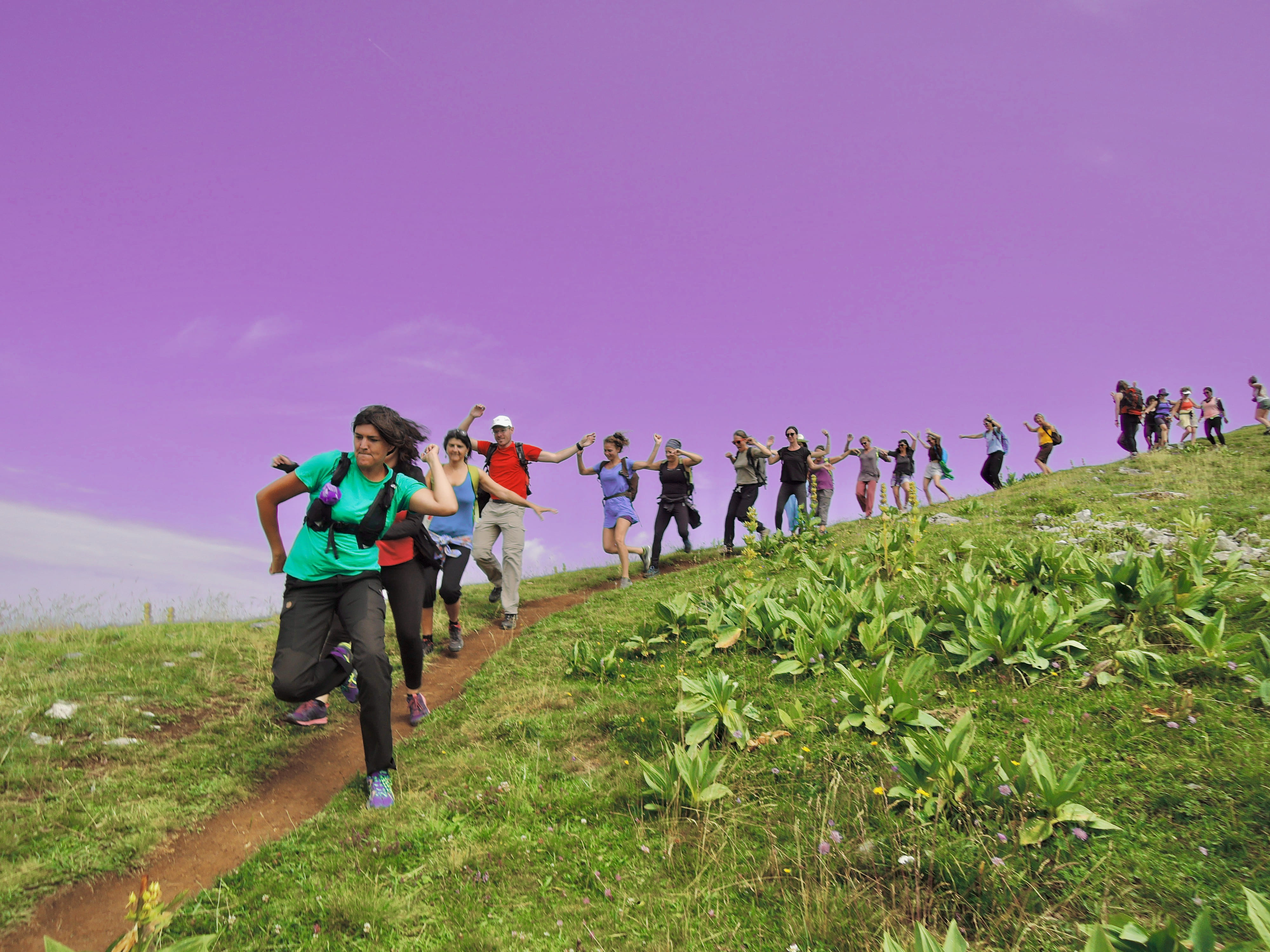The Foundational Figure of Georgian Choreology
Dance is one of the oldest forms of art. Georgian choreographic culture traces its roots back to as far as our collective memory extends. Georgian dance folklore has played a crucial role in shaping the artistic creativity of our ancestors. The synthesis of speech, music, and performance gave rise to a distinctive Georgian folklore, including mass and kinetic art forms such as Georgian folk dance. Georgian dance reveals expressive gestures, intricate rhythmic layers, and the unique spirit and temperament of the Georgian people, intimately tied to the vitality of the nation.
The roots of the Georgian nation run deep into ancient history, reflecting our past. However, compared to the long history of the art of dance, the scientific discipline of choreology is relatively young, barely a century and a half old. Although important historical sources, such as Kartlis Tskhovreba (The Life of Kartli) and Vakhushti Bagrationi's Aghts’era Sameposi Sakartvelosi (Description of the Georgian Kingdom), draw special attention to the art of choreography, this represents only a drop in the ocean. We still owe much to the enduring legacy of the genius of Georgian dance.
At the turn of the 19th and 20th centuries, amid a surge of national energy, Georgian hymns found dedicated guardians, Georgian song and dance found their way to the stage, and Georgian dancers and choreographers successfully combined scientific research with practical activities in choreography.
Today, Aleksi Aleksidze (1874–1934), also known as Aleksandre Songulashvili or, according to some documents, Sigulashvili (using the theatrical pseudonym Aleksidze), is recognized as the first researcher of Georgian folk dance. Born into a poor family, Aleksidze received no formal education, had no professional dance training, and first stepped onto the stage at the age of 12 or 13. Through immense talent and tireless effort, he opened the doors to Georgian choreography. The renowned ballerina, scholar, and choreologist Lili Gvaramadze dedicated an exceptional monograph, The Mtatsmindeli Motsekvave (Dancer from Mtatsminda), to him (this article primarily draws on that work).[i] Let us not forget that Aleksidze was not raised in the heart of Georgian folklore; he was part of urban life, where Georgian dance folklore had already lost its original form.
He first learned to stand on his toes when he was eight or nine years old, taught by a Lezgin neighbour boy who lived in the same courtyard. Soon, he became even better than his teacher at running on his toes. (The toe technique in male dances is a characteristic feature of the Georgian highlanders. The Svan dance Tseruli is entirely based on this toe dance technique. This style is also common among Lezgin, Ossetian, and Chechen-Kabardian men. Our nearest neighbors, the Armenians and Azerbaijanis, have never danced on their toes.)[ii] Later, in his neighbourhood, he encountered some impressive Dagestani folk dancers performing intricate tricks on the ground and rocks. Despite numerous attempts, he was unable to master the moves of falling to his knees, jumping up immediately, and standing on his toes. As he recalls it, on the last day of chasing the Lezgin dancers, a sudden thought entered his mind, fulfilling his long-held desire to dance.[iii] The leader of the nomadic/traveling troupe gave him permission, and Aleksidze danced on his toes around the circle. It seems he danced well, as the audience, standing on the balconies, rewarded him with applause. This dance not only gave him the opportunity to perform complex movements that he had long struggled to manage, but it also made the movements easier and determined the course of his future life. This is how Aleksi Aleksidze became a dancer.

Aleksi Aleksidze
In the 1880s, Lkhini (festive gatherings) often took place in houses with bani [flat roofs made of tamped earth] in Tbilisi. This fact was noted by the French traveler Louis Delaporte.[iv] Gradually, Aleksidze mastered dancing on the banis and earned the title of the best dancer of Mtatsminda. One day, a close relative of his, a great lover of the arts and a friend of actors at the Georgian Drama Theatre, asked Aleksidze's mother for permission to let the child dance at the theatre. This is how the 13-year-old boy first performed on a real stage – at a divertissement. He was given a single instruction: to dance from the middle of the stage, facing the audience. He almost fled the stage, but was saved by someone’s soothing and commanding voice: "Go! Keep dancing, stand on your toes!" This voice belonged to the famous Georgian writer, talented dancer, and incomparable performer of Davlur-Kartuli (traditional Georgian dances) and Khanjluri (sword dance) – Aleksandre Kazbegi, who played a decisive role in Aleksidze’s career.[v] Kazbegi’s dancing abilities must have had a profound influence on the young performer. It would have been impossible not to adopt Kazbegi's noble manner, his graceful body movements, and the striking brilliance of his dancing. The question of where and from whom Aleksidze learned to dance, and who should be credited for his performance of Georgian dances in such a traditional manner, is thus answered. This inspiring example gave him the opportunity to develop a refined taste from childhood and made him the best dancer in Georgia.
Aleksi Aleksidze danced in plays, operettas, and concerts. As a renowned dancer, he was invited to the Tbilisi Opera and Ballet Theatre, where he performed Georgian dances in the ballets Ruslan and Lyudmila and Demon.[vi] He made a name for himself as a brilliant performer of Georgian dances from 1895, and his fame grew when he traveled to Paris, where he returned as a winner with a large gold medal. In Paris, Aleksidze received favorable press coverage. The prestigious society of Paris was captivated by Georgian dances. French writer and journalist Jules Murie, who knew Aleksidze from Tbilisi, played a key role in this (Murie is the author of the book Ancient Colchis). Unfortunately, no written or photographic materials from his two-month stay in Paris and one-and-a-half-month tour in Lyon have been preserved (Aleksidze was robbed in Germany on the way back).
Aleksidze's pedagogical activities are a separate topic of discussion, which actually began immediately after his return from France. It was a time when the Georgian language and national dress were forbidden, and Georgian dances were mockingly labeled as "Asian." Through pedagogy, the artist came to understand the depth of Georgian dance—what dance truly is and its significance. It was then that he became a passionate advocate for Georgian dance and opened a studio to preserve Georgian choreoculture.[vii] For the first time, twice a week, the space for dancing was provided by Abdon Innocenti, a teacher of European and ballroom dances, and Maria Perini’s husband.[viii] In 1902, Aleksidze opened his own studio, which was open to all who wished to study Georgian folk dances. Aleksidze trained many remarkable students, one of whom was Iliko Sukhishvili, one of the founders of the legendary Sukhishvili company, which is famous worldwide.
The outstanding ballet reformer Mikhail Fokine, who had completely revolutionized the stagnant traditions of the St. Petersburg Imperial Ballet, took some lessons from Aleksidze in Tbilisi in 1916 to understand the inner nature of Georgian dance. Fokine, upon reflecting on this, told Aleksidze: "The dances I staged in London and Paris, in my own way, made a great impression on the public, but what I have learned from you is completely contrary to what I knew. It has shown me that I don’t truly understand your dances. From now on, when I want to stage something like this, I will be guided by the Georgian dance lessons I have learned from you.”[ix]
Aleksi Aleksidze did not write fundamental works on choreography, nor did he discuss the folklore context of Georgian folk dance or its historical development. He did not describe/explain Georgian dance according to its choreographic dialects, nor did he address stage choreography. Of course, he could not have done this without studying the dance and choreographic dialects from different parts of Georgia. However, standing at the origins of Georgian choreography, he paved the way for future choreographers and researchers. He opened a new arena for Georgian dance, where, alongside its greatness and beauty, all its difficulties and pains were also visible. His dream was to send an expedition to the regions of Georgia to study ancient Georgian dances. Several groups for such expeditions were indeed set up in the 1930s, but they were only tasked with recording songs and oral traditions. Aleksidze wrote about this fact: "I have great respect for the person who first came up with the idea to organise this expedition, because art is the beauty of the people's wealth and of the nation that has been developing for centuries—a precious treasure for the same people. Therefore, we have no right not to pass it on to the next generation, a treasure full of its own beauty.”[x]
Aleksi Aleksidze, as a choreologist, left us valuable insights into the origin, content, and character of certain dances, as well as sketches of dances (later restored by Lili Gvaramadze, such as Davlur-Kartuli and Mirzaia) and his descriptions of some dances. He was the first to refer to the crown of Georgian dance folklore, which had been mistakenly called lekuri, as "Kartuli" and proved the correctness of this name. He was a virtuoso performer of the Kartuli dance, performing it with his own style and variations.[xi] The great artist also addressed the question of the origin of dance: he believed that dance originated from "Pundruki," based on Sulkhan-Saba Orbeliani’s definition, which he viewed as a kind of gymnastic complex to which Georgians had attached great importance since ancient times.[xii] Specialists did not share his view, as the origin of choreography is generally considered to lie in the dance of hunters, not a complex of gymnastic movements. However, he never distinguished dance from gymnastics and acted as an advocate for physical culture. (In the next article, we will see how the great Georgian choreographer David Javrishvili adapted rhythmic gymnastics to Georgian folk choreography.) In this way, Aleksidze paid a kind of tribute to Nikolai Forger’s fashionable theory of making machines dance. Nevertheless, we all know that it is inappropriate to separate sports and gymnastics from dance, as they help beautify the body, strengthen it, improve breathing, and more.
In Aleksidze's records, there are detailed diagrams of many dances, descriptions of the technique for each movement, with explanations and alternations of movements. He refers to these movements as 'tricks' (Ileti - a dance movement) and was the one to introduce this term. He also established an important detail in the history of Georgian choreography: the duet 'Davluri' for two men and the group dance 'Davluri' are based on a contest, which seems to have been known at the end of the previous century.[xiii]
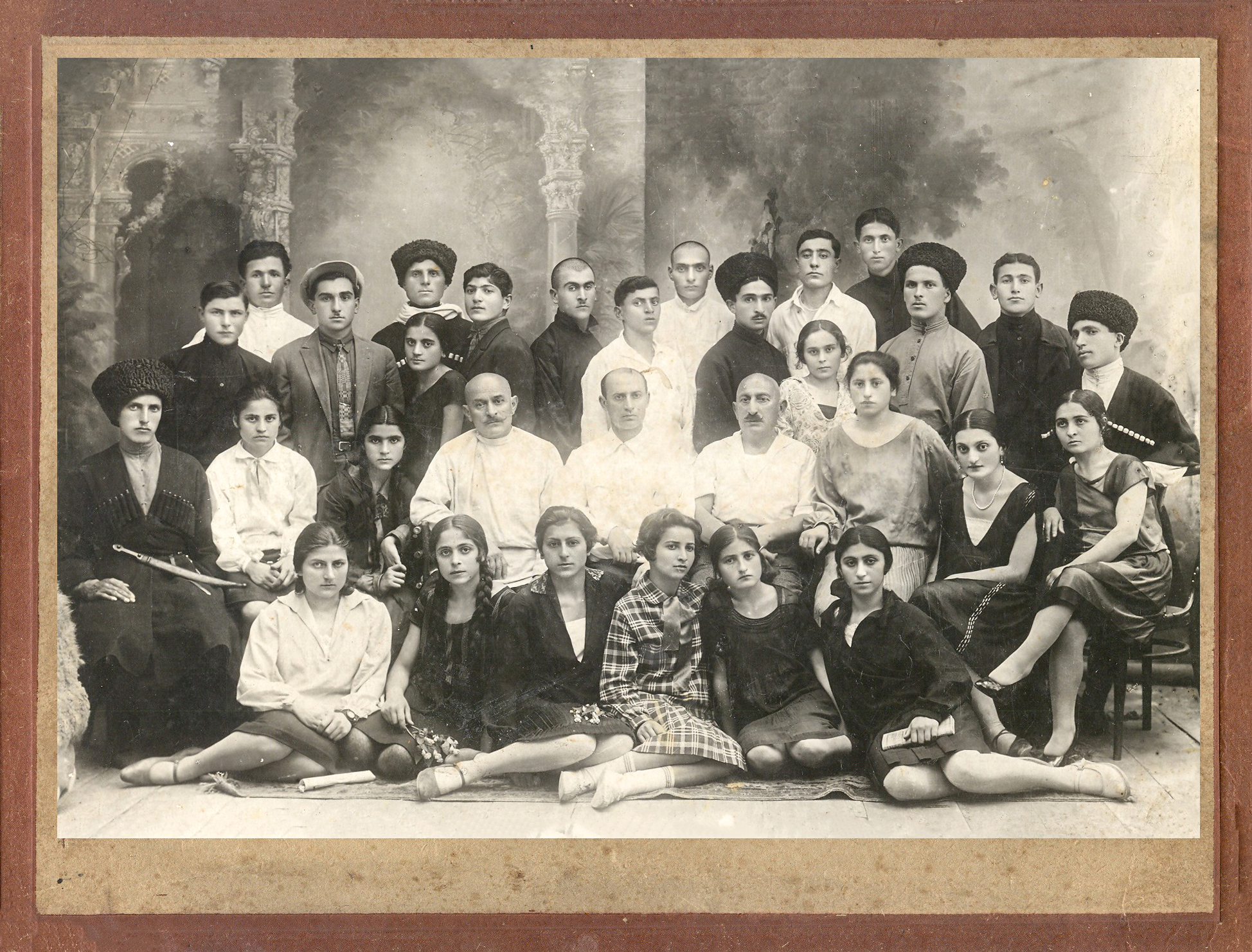
Second row, fourth from the left: Aleksi Aleksidze
Aleksidze also discusses the dance 'Samaia'(the fresco on the southern wall of Svetitskhoveli Cathedral) in his records. He considers 'Samaia' to be a group dance performed only by women. He did not attempt to analyze its content; his interest was solely in the musical accompaniment, although it is unclear whether the melody helped define Samaia's character, pattern, and techniques.
In addition to 'Samaia,' he also provided his own interpretation of the Kintouri dance and did not associate Kinto (in old Tbilisi, Kinto was part of the small merchant class. He was distinguished by his witty manner of communicating and his unique way of dressing) with any particular nationality.[xiv] He also describes the dance 'Shushpari,' or 'Mukhambazi,' a primitive round dance in honor of the moon, which was performed only at the royal court at that time and, eventually, survived in Svaneti. According to him, 'Shushpari,' or 'Mukhambazi,' is the same as ‘Baghdaduri.’"[xv]
On January 19, 1929, Aleksidze, with the help of his students, organised a ballet evening at the Rustaveli Theatre, consisting of three acts and four scenes. It was an attempt to create a complete dance performance. The evening was a success. The great maestro himself danced in the final act. The students warmly welcomed their beloved teacher.
Apart from the great love of the people and his name as a great artist, Aleksidze held no official title. Concluding the discussion about Aleksi Aleksidze, an incomparable dancer and the first Georgian choreologist, we will end with his own words: 'Often, even we, who were accustomed to it, were filled with admiration for a beautifully executed dance. And such beauty, belonging to the nation, its pride, should not prevent dance from developing more widely, alongside other arts.’[xvi]
[i] Gvaramadze, Lili. 2023. Kartuli Khalkhuri Tsekhva [Georgian Folk Dance]. Tbilisi: “Favorit Stili.”
[ii] Ibid., 484.
[iii] Aleksidze, Aleksi. 1933. Avtobiografia [Autobiography]. Manuscript. Fund of Manuscripts and Archival Documents, Palace of Arts of Georgia. p. 11.
[iv] Louis, Delaporte (1842–1925) — French traveler, researcher, and painter.
[v] Burtikashvili, Aleksandre. 1955. Aleksandre Kazbegi Stsenaze (Aleksandre Kazbegi on Stage). Tbilisi: “Khelovneba.” p. 86.
[vi] Kashmadze, Shalva. 1950. Tbilisis Operisa da Baletis Teatri [The Tbilisi Opera and Ballet Theatre]. Vol. I. Tbilisi: “Khelovneba.” pp. 292–307.
[vii] Gvaramadze, Lili. 2023. Kartuli Khalkhuri Tsekhva [Georgian Folk Dance]. Tbilisi: “Favorit Stili.” pp. 506-507
[viii] Maria Perini (1873-1939) was an Italian ballerina, choreographer, and the founder of the Georgian ballet school. Many outstanding masters of Georgian ballet art were trained in Perini's studio, including Dimitri and Irina Aleksidze, Maria Bauer, Vakhtang Chabukiani, Soloko Virsaladze, Nino Ramishvili, Iliko Sukishvili, Elene Chikvaidze, Maria Kazinetz, Lili Gvaramadze, and others. Abdon Innocenzi -- an Italian dancer, choreographer, teacher, and a graduate of the Milan Ballet School.
[ix] Gvaramadze, Lili. 2023. Kartuli Khalkhuri Tsekhva [Georgian Folk Dance]. Tbilisi: “Favorit Stili.” p.481.
[x] Ibid., 500
[xi] Aleksidze, Aleksi. 1929. Kartuli Tsekvis (Lekuris) Tvitmastsavlebeli [The Self-Teacher of Georgian Dance [Lezgin]]. Manuscript. Georgian Art Palace Manuscripts and Archival Documents Fund.
[xii] Orbeliani, Sulkhan-Saba. 1991. Lek’sikoni Kartuli [Georgian Dictionary]. Vol. II. Tbilisi: “Merani.” p. 204.
[xiii] Dance scheme/diagram: Davlur-Kartuli with a woman (undated, tracing paper, ink). Georgian National Museum, Archival and Manuscript Collection of the Palace of Arts of Georgia".
[xiv] Balakhashvili, Iakob. 1951. Dzveli Tbilisi [Old Tbilisi]. Tbilisi: “Sakhelmtsamurabelo Gamomcemloba.”
[xv] Gvaramadze, Lili. 2023. Kartuli Khalkhuri Tsekhva [Georgian Folk Dance]. Tbilisi: “Favorit Stili.”
[xvi] Ibid., 507
